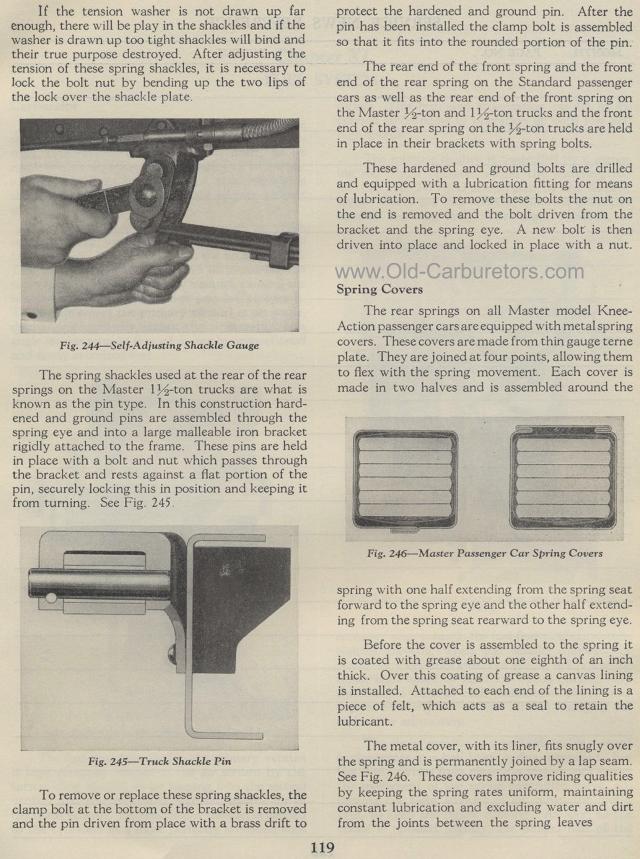Skip to: site menu | section menu | main content
If the tension washer is not drawn up far enough, there will be play in the shackles and if the washer is drawn up too tight shackles will bind and their true purpose destroyed. After adjusting the tension of these spring shackles, it is necessary to lock the bolt nut by bending up the two lips of the lock over the shackle plate.
Self-Adjusting Shackle Gauge
The spring shackles used at the rear of the rear springs on the Master 11A-ton trucks are what is known as the pin type.
In this construction hardened and ground pins are
assembled through the spring eye and into a large malleable iron
bracket rigidly attached to the frame. These pins are held in place
with a bolt and nut which passes through the bracket and rests
against a flat portion of the pin, securely locking this in position
and keeping it from turning. See Fig. 245.
Fig. 245— Truck Shackle Pin
To remove or replace these spring shackles, the clamp bolt at the
bottom of the bracket is removed and the pin driven from place
with a brass drift to
119protect the hardened and ground pin. After the pin has been
installed the clamp bolt is assembled so that it fits into the
rounded portion of the pin.
The rear end of the front spring and the front end of the rear
spring on the Standard passenger cars as well as the rear end of
the front spring on the Master Y2-ton and 1 %-ton trucks and the
front end of the rear spring on the %-ton trucks are held in place
in their brackets with spring bolts.
These hardened and ground bolts are drilled and equipped with a
lubrication fitting for means of lubrication. To remove these bolts
the nut on the end is removed and the bolt driven from the bracket
and the spring eye. A new bolt is then driven into place and locked
in place with a nut.
Spring Covers
The rear springs on all Master model Knee-Action passenger cars
are equipped with metal spring covers. These covers are made
from thin gauge terne plate. They are joined at four points,
allowing them to flex with the spring movement. Each cover is
made in two halves and is assembled around the
Fig. 246— Master Passenger Car Spring Covers
spring with one half extending from the spring seat forward to
the spring eye and the other half extending from the spring seat
rearward to the spring eye.
Before the cover is assembled to the spring it is coated with grease
about one eighth of an inch thick. Over this coating of grease
a canvas lining is installed. Attached to each end of the lining
is a piece of felt, which acts as a seal to retain the lubricant.
The metal cover, with its liner, fits snugly over the spring and
is permanently joined by a lap seam. See Fig. 246. These covers
improve riding qualities by keeping the spring rates uniform, maintaining
constant lubrication and excluding water and dirt from the joints
between the spring leaves
